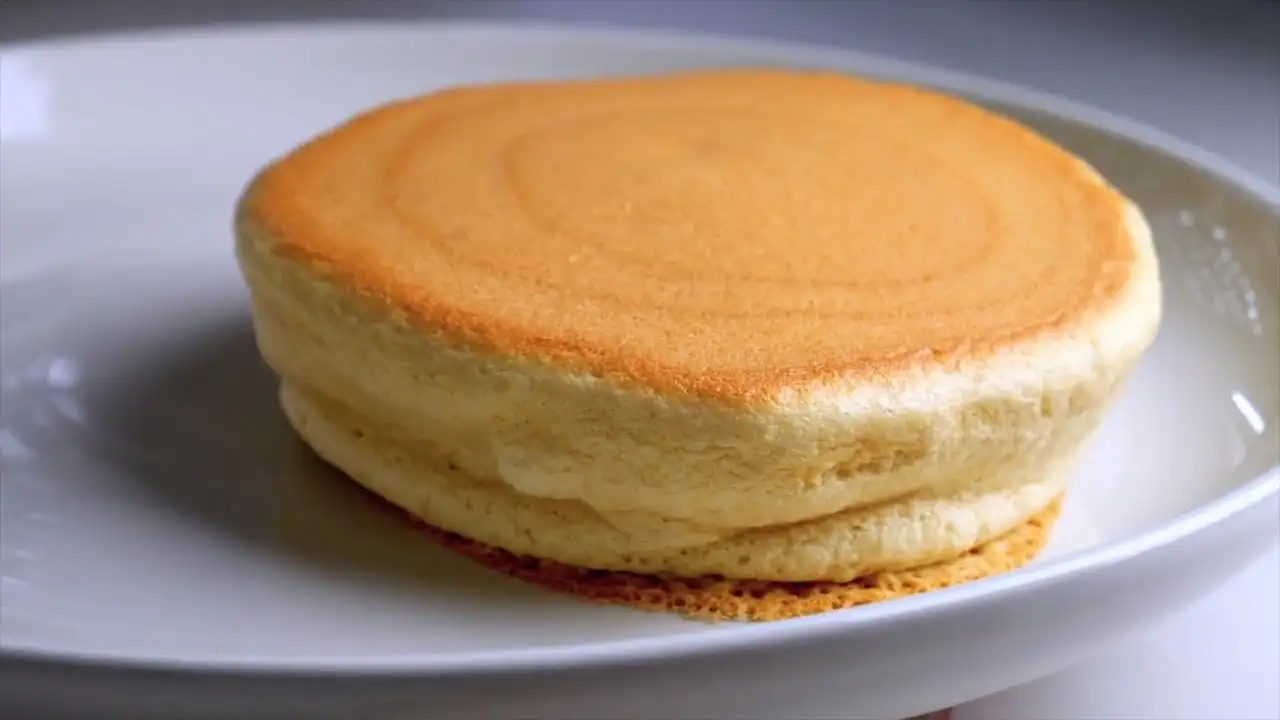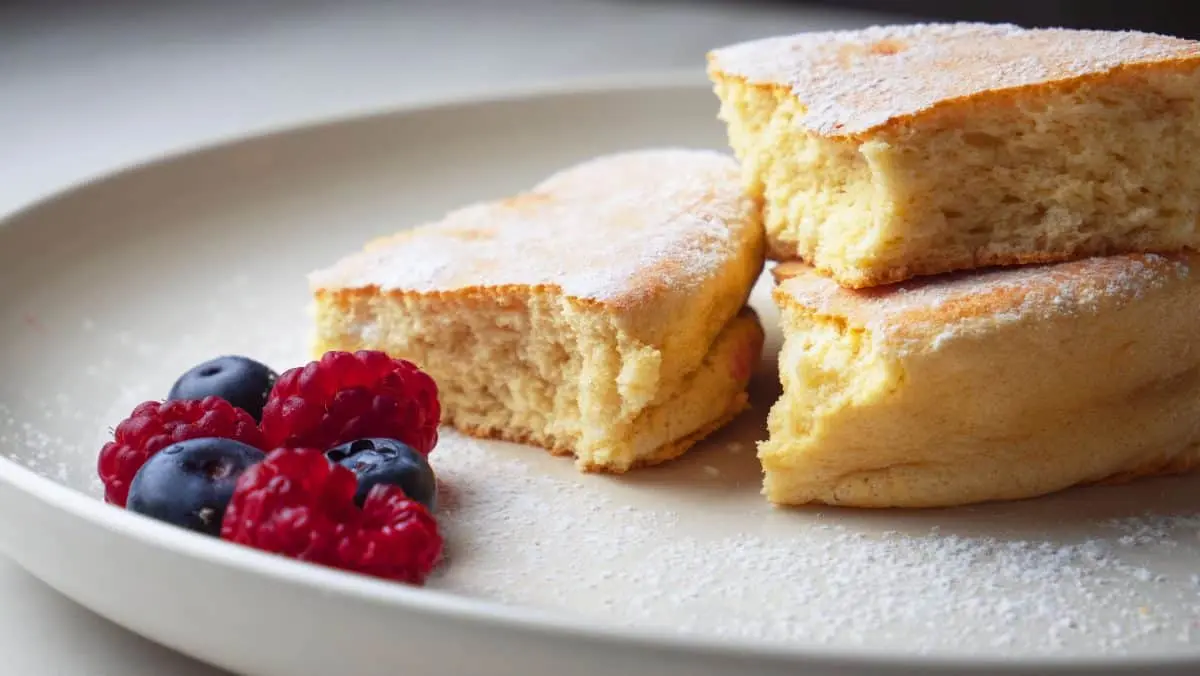Pancakes are a classic breakfast option as they are easy to prepare and can be customized with various toppings. But here’s the problem: I am not much of a fan of having something super sweet first thing in the morning. But I prefer Japanese soufflé pancakes that are super fluffy, airy, soft, and moist. These fluffy Japanese pancakes recipe are very popular in Japan, and people love them worldwide.
Instead of the traditional pancake, I have found a Japanese version that’s incredibly fluffy, more delicious, and definitely lighter on the sugar! In addition to being less sweet, this pancake is significantly thicker and taller compared to regular pancakes. Thanks to their sturdy structures and perfect rise, these pancakes look so aesthetic that they’re almost too pretty to eat!
Still craving the sugar rush? Go ahead and top the pancakes with fresh berries, whipped cream, or powdered sugar to have your way for a sugary treat!

All these conveniences, aesthetic appeal, and fluffy deliciousness come from a signature Japanese cooking method. It involves slow-cooking the pancakes at a lower temperature and whipping the egg whites differently, which allows them to rise perfectly. To let you in on these special tricks, in today’s recipe, I will walk you through making the fluffiest pancakes you have ever eaten!
How To Achieve The Signature Fluffy Japanese Pancake?
As I have already mentioned, the Japanese pancake is unique because of its soft texture and impressive height. To achieve this signature look and texture, there are some specific techniques involved. Here are a few pointers to get them just right:
Use The Right Ingredients
It’s crucial to select fresh eggs for this recipe. Fresh eggs whip better and can hold more air. Try to choose larger eggs with more whites.
I have used all-purpose flour in this recipe. However, for extra fluffiness, you can use cake flour, which results in airier and softer pancakes.
Whip Until Stiff Peaks
The way you whip egg whites determines how fluffy the pancakes will be. To achieve the perfect peak, make sure the mixing bowl and the beater you are going to use is completely grease-free.
Use a hand mixer or stand mixer to beat the egg whites. Beat until the whites form stiff peaks. When you stop beating, the foam should stand stiff without collapsing. Take extra caution to avoid over-whipping, as this may cause the egg whites to fall apart.
Perfect The Folding Technique
Instead of pouring all the egg whites into the batter at once, mix it in three stages, as I explained in the recipe. The critical thing to remember is to keep the structure of the egg whites you worked so hard to create while whipping. Please be patient and use a rubber spatula to fold the egg whites without causing any deflation.
Cook Over Slow Temperature
Phew! The hard part is over. After finishing the whipping and folding process, you can cook the pancakes at a low temperature to prevent burning. The low temperature allows the pancakes to rise properly without getting browned too quickly on the outside.

Serve With Care
Carefully lift the pancakes with a wide spatula and transfer them to a plate. Serve them immediately to enjoy the best quality, as letting them sit for too long might cause them to lose the beautiful, tall structure.
Tips For Making Fluffy Japanese Souffle Pancake
- While cooking the pancakes, maintain the cooking temperature as the recipe suggests. Do NOT raise the temperature, as cooking at a high temperature will cause the pancake to rise quickly. However, it will collapse immediately after cooling down.
- Cover the pan to ensure the pancakes get cooked all the way through. If the inside is undercooked even a little bit, the pancake will collapse as soon as it’s removed from the heat.
- As you have probably guessed, Japanese pancakes require careful handling to ensure the best result. To make things easier, preheat the pan over low heat and grease it well with oil or butter before so that the pancakes don’t get stuck to the pan while cooking.
- Don’t let the batter sit for too long before cooking. Leaving the batter causes it to go stale and develop large air bubbles. It’s best to start cooking as soon as the batter is ready.

- Once the edge of the pancake starts to set and the bubbles start forming, flip it using a spatula. Not flipping it in time may cause the pancake to have a soggy bottom and an unpleasant texture while eating. Use a wide and flat rubber spatula to have better control over flipping the pancakes.

Fluffy Japanese pancakes in just 20 Minutes | Pancake Recipe
Ingredients
For Egg Yolk Mixture
- 2 Egg yolks
- 3 tbsp / 45 ml Milk
- 2 tbsp / 24 g Sugar
- 1 pinch / 1 pinch Salt
- ½ tsp / 3 ml Vanilla essence
- 1 tbsp / 15 ml Vegetable oil
- ½ cup / 62 g All-purpose flour
- 1 tsp / 4 g Baking powder
For Egg White Mixture
- 2 Egg whites
- 1 tbsp / 12 g Sugar
For Cooking
- Oil to grease the pan
Equipments
Instructions
Whisk Egg Yolk and Dry Ingredients
- First, separate the egg yolks and whites from 2 large eggs in 2 different bowls.
- Add the milk, sugar, a pinch of salt, vanilla essence, and vegetable oil to the yolks and mix them.
- Then sift the flour and the baking powder into the egg mixture, mix everything well until it is smooth with no large lumps, and keep it aside.
Make The Meringue
- Now, using an electric mixer, start beating the egg whites on medium speed. After about 2 minutes, when the egg whites start to thicken up, add 1 tbsp sugar to that and beat them on medium-high speed for 2-3 minutes more or until stiff peaks form.
Fold The Egg Whites
- Add the egg whites to the pancake batter in 3 parts.
- Then carefully fold them into the batter until just incorporated, ensuring not to break air bubbles.
Make Souffle Pancake
- Place a griddle or nonstick pan over low heat and grease the pan with very little oil.
- Pour 2-3 spoons of batter into the first place, wait for 2 minutes, and add another spoon.
- Now cover and cook for 5 minutes until the center of the pancake is slightly jiggly. With a spatula, release the bottom of the pancake and carefully flip it over.
- Cover and cook for another 5 minutes on this side.
Serve and Enjoy!
- The pancake is ready! Make the rest following the same process, or you can make 2-3 together in the same pan.
- Dust them with icing sugar and serve them with your favorite fruits, syrup, whipped cream, or ice cream.
- Enjoy!
Video
Mornings are often the busiest time of the day. With a million things buzzing on my to-do list, all I can think about is how quickly I can get everything done and race out the front door on time.
That’s why I am all about quick recipes that make my mornings easier- like pancakes. And these Japanese pancakes are so yummy and delicious; they are totally worth every bite! Soft and airy, these fluffy pancakes give me the perfect start to the day with just the right touch of sweetness.
Recipe FAQs
Why Do My Pancakes Keep Sticking To The Pan?
If your pancakes are sticking to the pan, they may need more oil or butter to prevent that. Make sure the pan is well-greased and preheated on a low temperature to avoid this incident.
How To Make The Pancakes Recipe Healthier?
Replace the all-purpose flour in this recipe with whole grain flour. Serve the pancakes with fresh fruits such as berries, bananas, sliced apples or pears.
Why Do My Japanese Pancakes Deflate?
If you don’t beat your egg whites correctly, your pancakes will eventually deflate after they cool down. Underbeating or overbeating will cause the pancakes to deflate after cooking.
Also, please make sure you cook the inside of your pancakes properly; then, it will hold their structure after cooling down.
How Do I Achieve The Perfect Golden Brown Color In Pancakes?
Keep the temperature low and cook for a while to achieve a nice golden brown shade. For a quicker result, add a small amount of sugar to the batter, which will caramelize and give you a golden finish.


Leave a Reply